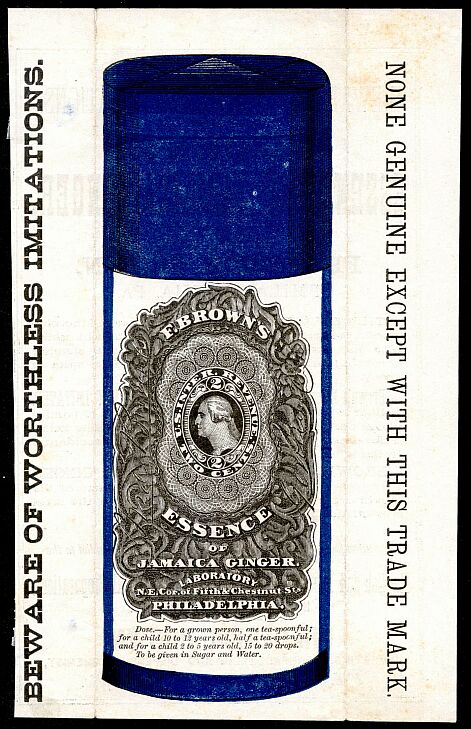
Frederick Brown Medicine Company
- the Counterfeit?

This is an advertising brochure for Brown's Essence of Jamaica Ginger. The depiction of the Brown stamp on the front matches most of the description of the "counterfeit" described in the Boston Book.
The description is as follows, "A counterfiet of Die 2 of this stamp has been submitted to us; the following being a description of it and the particulars wherein it differs from the genuine:
Size of engraving 105 1/2 x 52mm instead of 103 x 52mm, or two and one-half mm longer. This is due to the fact that, in the genuine, the directions just below the design proper are so close to it that the upper line cuts through the fine outer line of color which outlines the lower part of the design. This fine line is entirely missing over the "F" of "For"; the "P, R" and "S" of "Person", and the "T E A" and "P" of "Teaspoonful."


In the counterfeit this fine line of color is continuous and, while it is slightly waved, it makes no pretense of following the sinuousities of the outer edge of the design proper.
The directions are 1 1/2mm below the wavy line at their nearest approach to it and are in decidedly smaller type. In the genuine the four lines measure 48 1/2, 51 1/2, 49 1/2 and 34 1/2mm in length respectively, while in the counterfeit they measure 44 1/2, 49, 45 1/2 and 32mm.
In the genuine the "o" of "Dose" falls directly under the point of the left ornament of the frame; in the counterfeit the "D" is under the point.


The letters in the inscription "F. Brown's" are all well shaped and evenly shaded in the geniune. In the counterfeit they are not so well shaped and the exterior shading is too heavy and uneven, as, for example, under the "B R O", when it forms an unbroken line instead of following the outline of each letter and showing portions of the lined ground between them. This is equally true of the inscriptions in the lower half of the stamp. In the word "Essence" the final "E" is too far from the "C": the "OF" is particularly noticeable for its poor execution, the "F" being too short and squatty.




The shading under the word "Jamaica" is continuous under the letters "AMAI" in the genuine while, in the counterfeit, it extends further to the right so as to include the "C". In the genuine the words "Ginger" and "Laboratory" are particularly well formed and shaded. In the counterfeit the reverse is true, the shading under both words being practically continuous; here, too, the shading of the two lower lines of the inscription is so heavy as to make them appear to be in colorless characters upon a label of solid color.


The whole outline of the stamp, while it resembles the genuine quite closely, varies from it in many minor details. This is particularly noticeable in the shape of the upper, central projection which, in the genuine, is quite blunt and rounded, but is sharp and pointed in the counterfeit. The outer line, too, is too far away from the edge of the design.


In the genuine the lines of the groundwork and of the reticulation supporting the rosettes, as well as the rosettes themselves, are all clear and distinct. In the counterfeit they are all very blotchy, so much so as to give the appearance, under a glass, of blotches of color upon a white ground, instead of colorless lines upon a ground of solid color.
The head of Washington in the genuine is a clear and beautifully executed piece of work and the ground of the oval containing it is closely hatched with fine vertical and horizontal lines. In the counterfeit the head is a botch, much too heavily shaded, and the ground of the oval is of solid color.
It is undoubtedly printed from a lithographic transfer and is upon heavy, rather soft, white wove paper.
Some scholars maintain that there was a true counterfeit of the Brown stamp. It makes no sense that there would be one with an identical set of characteristics as the advertising copy unless some forger were so stupid as to copy it rather than a genuine one. There may have been one, but closer to the genuine design? Or does a mock-up for the advertising version exist, looking like an actual stamp?
There probably was a different advertising brochure as well, as there is writing on the back of the one shown above, and nobody would mistake it for an attempt to counterfeit the stamp unles someone carefully glued it to a backing. There are still some unanswered questions here.